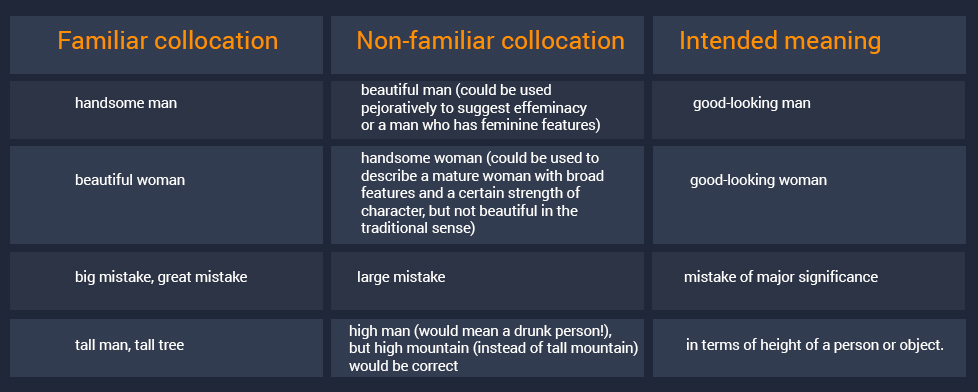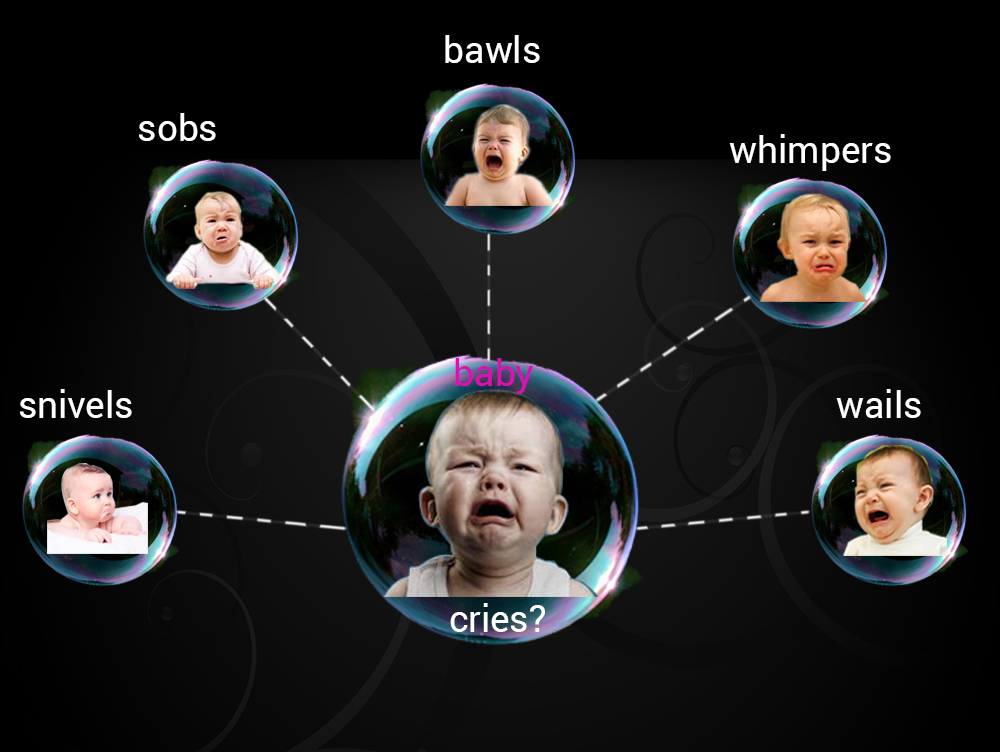What is collocation ?
A collocation is a sequence of two or more words that often occur together, i.e. more than by chance, to create a phrase. These phrases are so common that using a synonym for one of the words in the phrase can make it sound unnatural to a native speaker (hence we cannot use maroon wine instead of red wine or powerful tea for strong tea).
Collocation is the method by which words combine in a language to produce natural-sounding speech and writing.
Collocations and idioms are somewhat similar in that they are a set combination of words that are used by native
English speakers and there is no real iron-clad rule for using them correctly; you just have to learn them.
Collocations relate to the restrictions on how words can be used together, that is:
- which prepositions are used with particular verbs
- which verbs and nouns are used together
- whether certain adverbs precede or follow a verb
From a grammatical standpoint, simply using alternative words that mean the same thing shouldn’t make much of a difference. However, to a native speaker failure to make use of the correct collocation can cause some confusion and indicates that the writer is not fluent in the language.
Each genre has special collocations so that what is a normal collocation in one genre is not in another. This is the reason we have classified collocations as per domains (business, technical, general, etc.).

Why should collocation be taught in writing workshops?
Collocations help budding writers communicate ideas more effectively. A direct correlation exists between the use of collocations and proficiency in writing. Collocation is a helpful writing device that makes writing easier, more precise and more natural and native like. For instance, instead of saying ‘to read carefully or study’, we say ‘to pour over’.
Seasoned writers can create stylistic effects by purposely changing the normal patterns of collocation so as to startle or amuse their audience. However, to do this effectively it is best to have first learnt the standard usage of collocations.
Collocations can help:
- to maximise the value of language by making it more natural and easy to understand
- to make better use of language in alternative and richer ways
- to process and produce sentences at a much faster rate
- to broaden the scope for expression
- to remember words more easily as the human brain uses language in blocks rather than single words.
Knowledge of English collocations helps non-native writers immensely, as collocations are often perceived as arbitrary and overwhelming and create a major obstacle in acquiring native-like fluency.
Collocation may soon become so central and essential to everyday teaching that we will wonder why wasn’t it taught in-depth earlier!
How to learn and improve your use of collocations
The main difficulty in learning collocations is that there are no hard-and-fast grammar rules that stipulate how and when certain words go together; a writer has to develop “the feel” of how words are naturally used.
The unlimited number of collocations (literally several hundreds of thousands) in the English language makes teaching them all impossible. This makes Phrase It Right such a valuable aid to writers.
You may know a lot of individual words but may not know how to use them with certain other words to create different collocations that sound natural to native readers. To learn vocabulary, we can understand the meaning of the word by looking it up in a dictionary, but we may not know how to use the word in a sentence. The best way to learn vocabulary is to learn the collocations used with the word and then check how the phrase is commonly used in an example sentence.
The following sites can be used to find suitable example sentences:
In short, when you study vocabulary, learn whole phrases, not single words.Actively notice collocations when you are reading a book, newspaper, magazine or reference book to understand how other professional writers use certain phrases and common domain-specific collocations. Some examples are shown below:
- hot swapping (in IT)
- mistake proofing (quality assurance term used in business)
In general, academic writing uses standard collocations where the focus is to convey information whereas creative writing uses non-standard collocations to create dramatic effects.
Suitable collocation-related exercises are very useful for practicing the most common collocations of a word.Appropriate reference material can be used to learn and teach collocations. We will deal with this issue in greater detail in another blog post.
Writers should try to increase their vocabulary by using words in new ways to ensure that the writing is clear and crisp; not by using high-falutin words just for the sake of it. Be imaginative and creative in not only what you say but the way you say it.
For example, a baby doesn’t just cry. It can bawl, wail, whimper, howl, snivel or sob.


If you are writing about a topic, first locate all relevant collocations in the Phrase It Right toolkit. Add this list to a Microsoft Excel or Word document. You can also add terms under your Private Entries and add usage notes under Context.
Why are collocations difficult to learn?
Knowing when and how to link certain words is one of the most difficult things to learn, especially when the collocations may not seem to make much sense or to conform to any easily identifiable logic or rules.
Native English speakers intuitively frame the correct collocations based on a lifetime’s experience of hearing and reading the words in set combinations; the combination of words simply feels so natural that it rolls off the tongue. The non-native speaker has a more limited experience and may frequently collate words in a way that sounds odd to native speakers.
Writers face problems concerning word groupings mainly due to their ignorance of collocations. This problem has led to the widespread issue of what Michael Lewis calls “mis-collocations” or the wrong association of words.
A major stumbling block is the fact that there are so many possible collocations and that the choice of which word to collate with, say, a noun, is completely arbitrary. Writers can record collocations as they read about them (in the form of a Private Entry) and hence have a permanent record of which combinations are possible.
